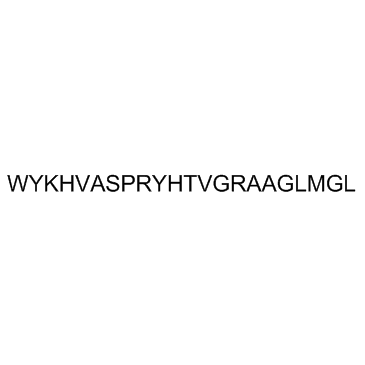Neuropeptide W-23 (human) trifluoroacetate salt
Modify Date: 2024-01-04 21:24:08

Neuropeptide W-23 (human) trifluoroacetate salt structure
|
Common Name | Neuropeptide W-23 (human) trifluoroacetate salt | ||
|---|---|---|---|---|
| CAS Number | 383415-79-0 | Molecular Weight | 2583.02 | |
| Density | 1.5±0.1 g/cm3 | Boiling Point | N/A | |
| Molecular Formula | C120H184N34O28S | Melting Point | N/A | |
| MSDS | N/A | Flash Point | N/A | |
Use of Neuropeptide W-23 (human) trifluoroacetate saltNeuropeptide W-23(human), the active form of Neuropeptide W, is an endogenous ligand for NPBW1 and NPBW2. |
| Name | Neuropeptide W-23 (human) |
|---|---|
| Synonym | More Synonyms |
| Description | Neuropeptide W-23(human), the active form of Neuropeptide W, is an endogenous ligand for NPBW1 and NPBW2. |
|---|---|
| Related Catalog | |
| In Vitro | NPW-23 increases the ICa,L in transfected human embryonic kidney 293 cells and VSMCs via GPR7. NPW-23 increases the expression of pan phospho-PKC, intracellular diacylglycerol level, and the second messenger catalyzed by PLC[1]. |
| In Vivo | NPW-23 increases pressure-induced vasotone of the rat mesenteric arteries. Importantly, the expression of NPW is decreased in the hypertensive rats[1]. NPW-23 (0.3 nmol, 1.0 nmol, and 3.0 nmol) induces significant increases in mean arterial pressure (MAP) in conscious, freely moving male rats. Rats that receive either 1.0 or 3.0 nmol NPW-23 demonstrate a significant increase in total activity, ambulatory activity, and duration of stereotypy. NPW-23 fails to elevate MAP in rats pretreated with phentolamine. NPW-23-induced increases in total activity, ambulatory activity, and duration of stereotypy are reduced significantly by pretreatment with the orexin type 1 receptor (OX1R) antagonist, SB-408124[2]. |
| Animal Admin | Cardiovascular experiments are conducted the day after carotid implantation. On the day of the experiment, animals are habituated to a quiet room for at least 2 h. The carotid cannula is flushed with heparinized saline (200 U/mL in 0.9% NaCl) and connected to a pressure transducer. Baseline MAP is recorded for at least 30 min at 1-min intervals. For all experiments, preinjection baseline is calculated as the average MAP for 10 min before intracerebroventricular injections of saline or NPW-23. To test the cardiovascular effects of centrally administered NPW-23, rats are treated intracerebroventricularly with vehicle or vehicle containing 0.3, 1.0, or 3.0 nmol NPW-23. MAP is recorded for at least 45 min at 1-min intervals. To determine the potential role of sympathetic activation in mediating NPW-induced MAP increase, rats are pretreated intra-arterially with the α-adrenergic antagonist phentolamine-HCl (10 mg/kg body wt in 0.9% NaCl) or saline 15 min before central injection of saline or saline containing 1.0 nmol NPW-23. In a final experiment, the OX1R antagonist, SB-408124, or vehicle is injected intracerebroventricularly 15 s prior to 1.0 nmol NPW-23, and MAP is monitored for 45 min at 1-min intervals. |
| References |
| Density | 1.5±0.1 g/cm3 |
|---|---|
| Molecular Formula | C120H184N34O28S |
| Molecular Weight | 2583.02 |
| LogP | -0.21 |
| Index of Refraction | 1.668 |
| Storage condition | -20°C |
| L-Tryptophyl-L-tyrosyl-L-lysyl-L-histidyl-L-valyl-L-alanyl-L-seryl-L-prolyl-L-arginyl-L-tyrosyl-L-histidyl-L-threonyl-L-valylglycyl-L-arginyl-L-alanyl-L-alanylglycyl-L-leucyl-L-leucyl-L-methionylglycyl-L-leucine |
| L-Leucine, L-tryptophyl-L-tyrosyl-L-lysyl-L-histidyl-L-valyl-L-alanyl-L-seryl-L-prolyl-L-arginyl-L-tyrosyl-L-histidyl-L-threonyl-L-valylglycyl-L-arginyl-L-alanyl-L-alanylglycyl-L-leucyl-L-leucyl-L-methionylglycyl- |
| Neuropeptide W-23(human) |

